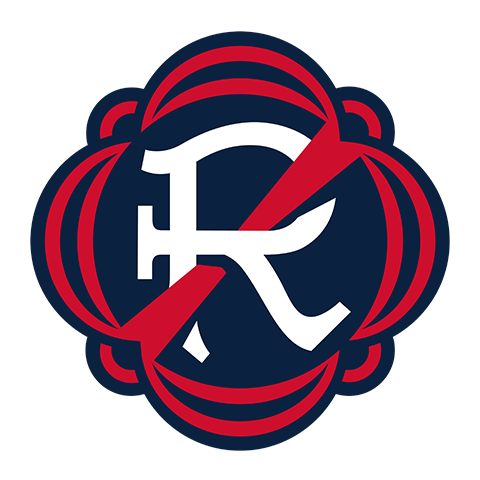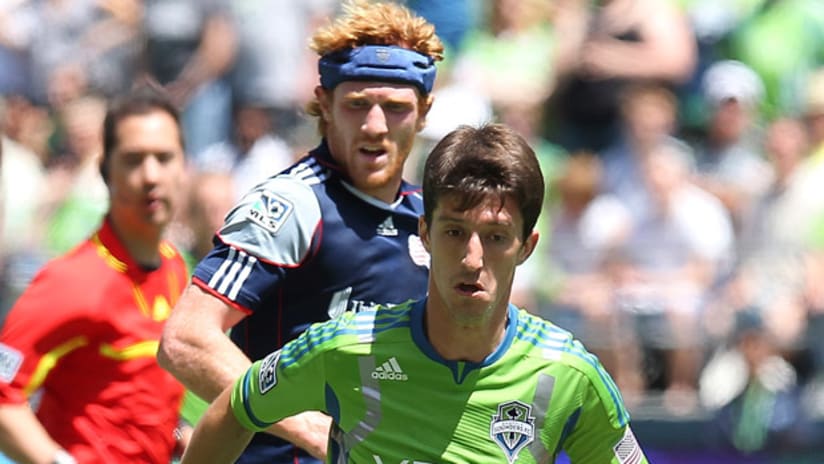The following story was published in the Revolution’s “Match Day” program for the August 20 game against the New York Red Bulls
FOXBOROUGH, Mass. – When Pat Phelan clashed heads with then-Chicago Fire midfielder Peter Lowry while challenging for a loose ball during a SuperLiga group game on July 17, 2010, the dozen stitches required to close the gash near his left temple served as a final, ruthless wakeup call.
Phelan lay prone on the grass at Toyota Park for several minutes while receiving medical attention, awakening eerily familiar memories of a similar head injury Phelan had suffered in another SuperLiga group game two years prior – almost to the day – in 2008. That night at Gillette Stadium as the New England Revolution battled Mexican club Pachuca, Phelan accidentally collided with teammate Sainey Nyassi while defending a corner kick. Knocked unconscious by the impact, Phelan was stretchered off the field with his neck immobilized and was taken to Mass General Hospital for further tests.
Remarkably, neither injury sidelined Phelan for more than couple of weeks. In fact, the rugged midfielder returned just three days after his 2010 clash with Lowry to help the Revs complete an unblemished run through the SuperLiga group stage and felt no further effects from the collision.
But despite the relatively minimal consequences of those particular knocks, Phelan came to the realization that he could no longer test his luck with regards to his brain. Beginning with a league match against the Philadelphia Union on July 31, 2010, Phelan began wearing protective headgear designed by Full90 Sports. He’s worn it ever since.
“I think I’ve had six diagnosed concussions and I’ve gotten hit in the head several times,” said Phelan, who plies his trade in the rough-and-tumble realm of defensive midfield. “Fortunately, none of them have been too severe. I know with some people they can have dozens of concussions and not really have any repercussions, but guys like Taylor (Twellman) took one bad hit and it’s really all it takes. So if I can avoid that, it’s something I’m going to try to do.
“The first couple of years I was here, I had a significant head injury every year and I’ve had several in the past,” Phelan recalled. “If you tie that together with the end of Taylor’s career, it just sort of made sense (to wear the headgear).”
Phelan’s decision to protect his head with Full90 was heavily influenced by the premature retirement of his former teammate Twellman, the Revolution’s all-time leading scorer who was forced to end his playing career at the age of 30 because of ongoing medical issues stemming from a head injury.
While scoring a goal against the LA Galaxy on Aug. 30, 2008 – when Twellman was just 28 years old – the fearless U.S. National Team forward suffered a blow to the head in a collision with then-Galaxy goalkeeper Steve Cronin. Despite his best efforts to return from the debilitating injury, Twellman was limited to just two appearances in 2009 and was unable to play at all in 2010, leading to his eventual retirement.
Watching Twellman’s battle unfold before him had an intense effect on Phelan.
“When I got traded here (from Toronto in June 2008), he picked up the initial injury shortly thereafter,” Phelan said of Twellman. “I was really excited to play with him and we never really got the opportunity to play with each other too much. So I had to witness his entire struggle with that sort of thing, and I didn’t want to go down that road. So while we didn’t talk about it, it definitely had a profound influence.”
The decision to wear protective headgear was driven both by Twellman’s ill-fated story and Phelan’s own brushes with head trauma, but it was not at the recommendation of a doctor. Instead, Phelan made the choice to protect himself by his own volition.
It’s a decision Phelan says he’ll never regret, despite the initially challenging task of learning to play with an additional piece of equipment strapped to his head.
“It just takes some getting used to,” said Phelan. “I wore it in practice for a while to get used to the way the ball comes off of it, because it plays pretty true, but it’s still a little different. But other than that, I don’t really notice it anymore. It actually feels weird not wearing it now.
“It might look kind of silly,” Phelan admitted. “Some people might think that, but it’s just like wearing shin guards or something like that. You’re just trying to protect your body.”
For Phelan, any minor inconveniences like aesthetic value – “It’s not a fashion statement,” he joked – or slight adjustments in heading the ball are more than worth it for the protection the Full90 headgear provides. In fact, Phelan claims to have experienced the headgear’s benefits on multiple occasions since he began wearing it a little more than one year ago.
“The couple of times when I’ve taken it off or haven’t worn it I’ve gotten hit, as well, and it’s kind of reminded me that I should be wearing it as much as possible,” he said. “I’ve absolutely had several occasions in the short time that I’ve been wearing it when I’ve gotten hit where I can just tell. I still got my bell rung a little bit with it on, but had I not been wearing it, it probably would’ve been much worse.”
That’s why it was surprising to see Phelan emerge from the locker room without the headgear for the second half of two games in July, when the Revs played in scorching temperatures at RFK Stadium (Washington, D.C.) and Dick’s Sporting Goods Park (Commerce City, Colo.). With temperatures at kickoff eclipsing 90 degrees on both nights, Phelan’s headgear had an unforeseen and undesired effect.
As Phelan dripped sweat after running around in the heat for 45 minutes, the equipment began to soak up the perspiration and essentially became a weight the midfielder was carrying around on his head. For one of the first times in a year, Phelan made the bold decision to willingly discard the headgear after the halftime break.
“It holds the sweat and your head just needs to be able to breathe in humidity like that,” Phelan said. “It was a decision I made that I’m glad didn’t come back to bite me in the rear.
“I was trying to be conscious of the challenges I was going into and not put myself in situations where I might get hit in the head,” he admitted. “Fortunately, I got away with it, but I’ll try to avoid doing that as much as possible.”
While Phelan was unsure how long he’d actually wear the headgear when he first donned the equipment back in July 2010 – “It was more just to try it out and see if it would work for me,” he said. “It just kind of stuck” – he’s positive he’ll continue to protect his head for the remainder of his professional soccer career. In fact, he envisions his involvement with Full90 potentially reaching past his playing days.
“I think I’d like to get involved with some sort of product development with them,” Phelan said. “I think I’m the only one in MLS [wearing] the Full90 consistently. So I’m trying to get involved, hopefully help them develop it a little more. Because I think you’ve seen in so many other sports, particularly football, that post-concussion syndrome is really affecting athletes after they’re done playing, as well.
“I know some local teams have instituted mouth guards and things like that to try and prevent those sorts of things,” he continued. “I think it’s something that should catch on.”
Phelan’s reference to post-concussion syndrome and the potential lifelong effects of head trauma reveals the major difference between brain injuries and most other ailments in professional sports. While many athletes protect their bodies to avoid missing playing time through injury – including Phelan, who rarely finds himself on the Revolution’s injury report – Phelan protects his head to avoid missing out on the simple joys of daily life.
“Obviously I want to keep myself in good health so I can play, but you can only be a soccer player for so long,” Phelan said. “I’m not going to retire off playing soccer. I understand that, so life after soccer is very important to me. I just want to do what I can to protect myself and give myself the best chance to succeed off the field whenever I’m done playing.”







